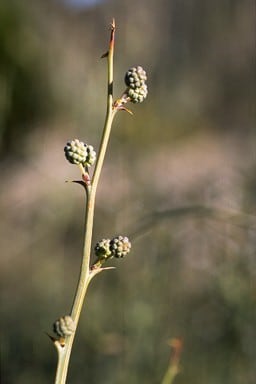Acacia daviesioides C.A.Gardner
WATTLE
Acacias of Australia
Family
Fabaceae
Distribution
Disjunct, occurring from near Mingenew SE to Ballidu–Kalannie, with outliers at Jingemarra Stn (c. 200 km NE of Mingenew) and near Mt Jackson (c. 200 km E of Kalannie), south-western W.A.
Description
Much-branched intricate glabrous shrub 0.3–1 m high. Branches straight or flexuose, terete, sometimes angled, striate, glaucous to subglaucous, sometimes green. Stipules linear to linear-triangular, 1–3 mm long. Phyllodes continuous with branchlets, sometimes decurrent and forming narrow wings at base of stems or on regrowth plants; free portion of phyllodes shallowly recurved to straight, flat to pentagonal or terete, 2–10 (-20) mm long, narrowed towards apex, spinose, rigid, glaucous to subglaucous, 5-nerved; main nerves prominent; adaxial margin 2-nerved; gland 1–2.5 (–5) mm above base. Inflorescences very reduced 1–3-headed racemes, sometimes growing out at anthesis; peduncles 3–10 (–12) mm long, recurved from base in fruit; heads globular, 15–24-flowered, light golden. Flowers 5-merous, a few 4-merous; sepals shallowly or deeply united. Pods linear, straight-edged or a little constricted between seeds, alternately raised over seeds, to 8 cm long, 3–5 mm wide, coriaceous-crustaceous, pruinose when young. Seeds longitudinal, broadly oblong to oblong-elliptic, 2.5–3 mm long; aril large.
Habitat
Grows in sand, loam and sandy clay, often with gravel, in heath, open scrub and shrubland.
Specimens
W.A.: near Kalannie on Dalwallinu road, A.M.Ashby 4245 (PERTH); halfway between Mingenew and Morawa, A.M.Ashby 5200 (NSW, PERTH); 4 km S of Jingemarra HS, R.J.Cranfield 6031 (PERTH); 8.8 km S of Wubin towards Dalwallinu, B.R.Maslin 3528 (CANB, MEL, NY, PERTH); N of Mt Jackson, M.H.Simmons 1236 (PERTH).
Notes
Related to A. cerastes, which is distinguished by its tortuous, green or brown branchlets and rudimentary phyllodes; see B.R.Maslin, Nuytsia 10: 173 (1995), for further discussion.
Specimens with angled branchlets due to decurrent phyllodes may resemble short phyllode forms of A. trigonophylla which are most easily distinguished by their green stems, non-racemose inflorescences and submoniliform pods.
Some specimens, including the type, have flexuose branches with tuberculate ribs. Otherwise the branches are ±straight and the ribs smooth.
FOA Reference
Data derived from Flora of Australia Volumes 11A (2001), 11B (2001) and 12 (1998), products of ABRS, ©Commonwealth of Australia
Author
B.R.Maslin
Minor edits by J.Rogers
This identification key and fact sheets are available as a mobile application:
URL: https://apps.lucidcentral.org/wattle/
© Copyright 2018. All rights reserved.











